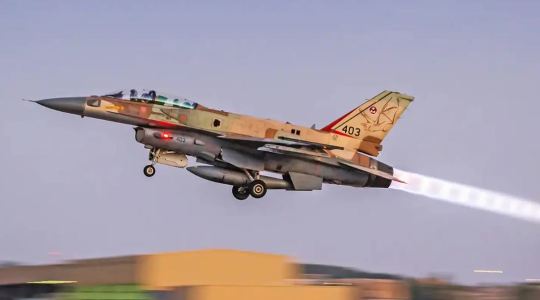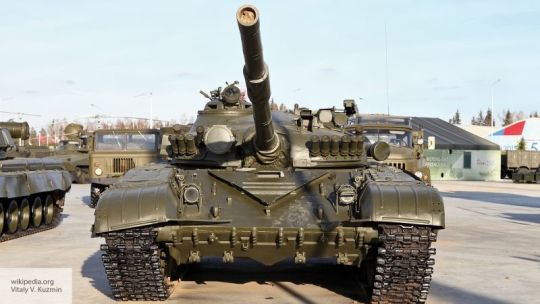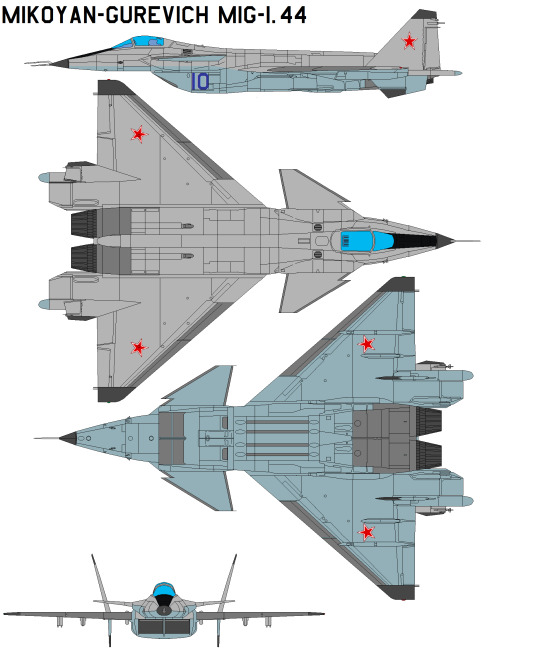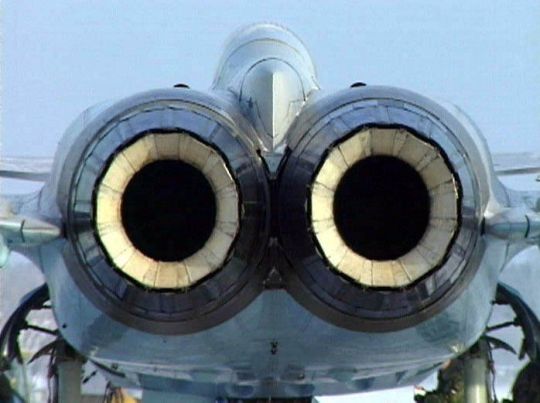#vitaly v kuzmin
Text
At this time, about 9 countries of the world have approximately 9000 nuclear weapons. Russia is on the top with 4477, and America on second with 3708 numbers of nuclear weapons.
📸: Wikimedia Commons / Vitaly V. Kuzmin

2 notes
·
View notes
Text

Russia-operated S-300 SAM system is fired at Israeli jets over Syria
The latest allegations from the Israeli Ministry of Defense occur amid the worsening of relations between Israel and Russia.
Diego Alves By Diego Alves 07/28/2022 - 08:00 AM in Military
Israeli Air Force/Amit Agronov
An S-300 air defense system operated by Russia fired at Israeli Air Force (IAF) fighter jets, which operated over Syria, according to new information provided by the Israeli Ministry of Defense.
The fact that it was a Russian manned air defense battery that engaged Israeli jets is significant and adds details to the incident. This occurred in May, as we reported at the time, but it had not been confirmed by the authorities so far.
Israeli Defense Minister and Deputy Prime Minister Benny Gantz told reporters today that the IAF jets were attacked by the Russian long-range surface-to-air missile system (SAM) on May 13, but came out unscathed. Gantz, however, tried to minimize the presence of the Israeli aircraft in Syrian airspace and described the whole case as a "single incident".

Israeli Defense Minister and Deputy Prime Minister Benny Gantz speaks in Jerusalem last month. Photo by Amir Levy/Getty Images
Gantz added that the Russian missiles were launched when the IAF jets "were no longer around". The claim that the jets left the area may suggest that the Russians tried to do both, making a statement with the launch of a missile, but that it was never really threatening to Israeli jets. Russia, for its part, has so far made no comment on the incident.
Previous reports indicated that the aircraft involved were IAF F-16s, which hit targets near the city of Masyaf in northwestern Syria, although no more details on these aspects were provided.
As we reported at the time, the May incident seems to have been the first time that the S-300 has been used against Israeli jets since these air defense systems began arriving in Syria in 2018, as part of the Kremlin's support for the Assad regime. Part of the reason for the introduction of these missiles was to strengthen Syrian air defenses after they shot down a Russian Il-20 Coot surveillance aircraft by mistake, killing all 15 on board, amid IAF airstrikes along the Mediterranean coast.
The exact type of S-300 missiles deployed in Syria is unknown, but they may include one of several oldest systems in the S-300P series, known in the West as SA-10 Grumble, or the most advanced S-300PMU-2, known as SA-20B Gargoyle, which has an increased range of up to about 124 miles.

A 5P85SE2 motor launch vehicle of an S-300PMU-2 system is exhibited at the MAKS International Aviation and Space Show in 2009. Vitaly V. Kuzmin
Although Gantz declared that the S-300 in question was operated by Russia, we do not know how this was determined and it is fair to say that there is some confusion about the precise assignments and organization of these systems.
Previously, Russia had declared that it would control the release of missiles launched from 'Syrian' S-300 batteries in the country. This was seen as one of the main reasons why the missiles of these systems were never launched against the IAF during previous air encounters. The same goes for the more advanced S-300 and S-400 batteries that are known to be in Russian hands and are based on important Russian strongholds at Tartus and Khmeimim Air Force Base.
This contrasts sharply with previous air defense systems manufactured by the Soviet Union in the Syrian arsenal, which have been used ?? regularly against IAF aircraft attack targets in the country. On some occasions, these missiles were simply launched into the air on ballistic trajectories, apparently in recognition of their limited capacity against modern Israeli fighters.
It is not clear what may have changed before the May 13 incident. When it was first reported, Israel's Channel 13 said that the 'Russian' S-300 batteries were involved, although the same exit also made it clear that Moscow's direct control over their use made such weapons in Syria in fact Russian, regardless of their actual assignment.
It is also entirely possible that the battery in question is or has been operated jointly by Syrian and Russian air defense troops. On the other hand, if one of Tartus or Khmeimim's batteries were used, it would clearly indicate an all-Russian engagement.
Regardless, as of 2015, the Kremlin and Israel operated a deconflict mechanism to ensure that the IAF airstrikes were not engaged by Russian forces in Syria.
In practice, this meant that Russian forces in Syria were closing their eyes to the IAF attacks on targets in Syria.
However, as tensions between Israel, Syria and Russia began to increase more recently, the long-term status of this conflict agreement has become questionable. In mid-May, at least, it seems to have broken, either permanently or not.
This coincided with Israel's decision to start supplying weapons to Ukraine, to help that country in its ongoing war with Russia. Before that, Israel had been taking a generally more cautious approach to events in Ukraine, although it was forced to challenge some extremist rhetoric from Russian authorities.
Since then, tensions between Russia and Israel have only worsened, which may be the reason for the specific disclosure about the S-300 incident today, which is unusual.
Recently, the Israeli government criticized Russia's conduct in the Ukrainian war, while Moscow, in turn, is caught in a dispute with a Jewish emigration agency that also attracted Israeli Prime Minister Yair Lapid.
With these problems in the background, Ganz today has made apparent moves to reduce the potential for more disagreement between the two countries. Without explicitly referring to the deconflict mechanism, the Minister of Defense said that coordination with Russia on Syria is "a stable situation at the moment". He added: "But we are always reviewing this story as if we had just started now."
As for the status of IAF operations on Syria, the May 13 incident is unlikely to greatly change Israeli policy, if it changes.

Technicians set up an F-16I.
In particular, Israel has repeatedly shown its willingness to attack Iranian arms transfers to militants in Syria and Lebanon, as well as Iran-backed arms factories and weapons hiding places in Syria. Certainly, airstrikes like these are far from "unique incidents", as Ganz said today, although they may have decreased in intensity in recent months.
However, as long as these airstrikes continue, S-300 batteries in Syria, in general, will continue to be part of the IAF's planning. Israeli pilots regularly train against S-300 systems, especially to improve their tactics in a possible conflict with Iran, and the IAF has a lot of experience in employing electronic warfare systems, removal weapons and tailor-made tactics to protect its fighters from these types of weapons attacks.
Although Israeli jets have suffered friction over Syria in the past, with an F-16 Sufa falling in early 2018, authorities declared this loss in particular due to a pilot error.
On both sides, an IAF fighter dropping to a Russian-operated S-300 would pose all kinds of problems, up to the highest political levels. With this in mind, it is very likely that both countries will actively seek to avoid it. With Israeli-Russian relations already tense, Ganz's statements today may well be a warning to Russia not to interfere in its operations again.
Tags: Military AviationIAF - Israeli Air Force/Israel Air ForceIranRussiaSAM S-300War Zones
Previous news
Textron AT-6E obtains military type certification from USAF
Next news
US Navy helicopters suffer damage after storm in Norfolk
Diego Alves
Diego Alves
Related news
COMMERCIAL
Iran will support maintenance of Airbus and Boeing aircraft operated by Russia
07/28/2022 - 4:00 PM
MILITARY
IMAGES: USAF sends F-22 Raptors to Poland on NATO air armor mission
07/28/2022 - 12:00 PM
MILITARY
IMAGES: The first E-3D Sentry of the Chilean Air Force arrives
07/28/2022 - 11:00 AM
MILITARY
Textron AT-6E obtains military type certification from USAF
07/28/2022 - 07:00 AM
BRAZILIAN AIR FORCE
VIDEO and IMAGES: New KC-30 aircraft is incorporated into the Brazilian Air Force
07/27/2022 - 10:33 PM
MILITARY
Tempest program and Russian invasion boost the growth of Italy's defense budget
07/27/2022 - 5:00 PM
HOME Main Page Editorials Information Events Collaborate SPECIALS Advertise About
Cavok Brasil - Digital Tchê Web Creation
Commercial
Executive
Helicopters
History
Military
Brazilian Air Force
Space
SPECIALS
Cavok Brasil - Digital Tchê Web Creation
3 notes
·
View notes
Text
On this day in Wikipedia: Thursday, 11th April
Welcome, vitajte, mirë se vjen, أهلا بك (ahlan bika) 🤗
What does @Wikipedia say about 11th April through the years 🏛️📜🗓️?

11th April 2023 🗓️ : Event - Myanmar Air Force
A Myanmar Air Force airstrike killed at least 100 villagers in Pazigyi.
"The Myanmar Air Force (Burmese: တပ်မတော် (လေ), pronounced [taʔmədɔ̀ (le)]), known until 1989 as the Burmese Air Force, is the aerial branch of Myanmar's armed forces, the Tatmadaw. The primary mission of the Myanmar Air Force (MAF) since its inception has been to provide transport, logistical, and..."

Image licensed under CC BY-SA 3.0? by The original uploader was Roshan220195 at English Wikipedia.
11th April 2018 🗓️ : Event - Ilyushin Il-76
An Ilyushin Il-76 which was owned and operated by the Algerian Air Force crashes near Boufarik, Algeria, killing 257.
"The Ilyushin Il-76 (Russian: Илью́шин Ил-76; NATO reporting name: Candid) is a multi-purpose, fixed-wing, four-engine turbofan strategic airlifter designed by the Soviet Union's Ilyushin design bureau as a commercial freighter in 1967, to replace the Antonov An-12. It was developed to deliver heavy..."

Image licensed under CC BY-SA 4.0? by Vitaly V. Kuzmin
11th April 2014 🗓️ : Death - Bill Henry (baseball, born 1927)
Bill Henry, American baseball player (b. 1927)
"William Rodman Henry (October 15, 1927 – April 11, 2014) was an American professional baseball player. A left-handed pitcher, he appeared in Major League Baseball between 1952 and 1969 for the Boston Red Sox, Chicago Cubs, Cincinnati Reds, San Francisco Giants, Pittsburgh Pirates, and Houston..."

Image by Bowman Gum
11th April 1974 🗓️ : Birth - David Jassy
David Jassy, Swedish singer-songwriter and producer
"David Moses Jassy, also known as Dawda, is a Gambian/Estonian musician, songwriter and music producer. With Andrés Avellán, he was part of a Swedish R&B hip hop duo, Navigators. After split up of the group, Jassy went on to writing music and producing a number of international acts such as Ashley..."

Image licensed under CC BY 3.0? by Copyright holder:David Jassy
11th April 1924 🗓️ : Birth - Mohammad Naseem
Mohammad Naseem, Pakistani-English activist and politician (d. 2014)
"Mohammad Naseem, (Urdu: محمد نسیم; 6 September 1924 – 22 April 2014), was a British Muslim leader and political activist. Nassem worked as a GP before later becoming chairman of the Birmingham Mosque Trust (Birmingham Central Mosque), one of the largest and most prominent Islamic places of worship..."
11th April 1819 🗓️ : Birth - Charles Hallé
Charles Hallé, German-English pianist and conductor (d. 1895)
"Sir Charles Hallé (born Karl Halle; 11 April 1819 – 25 October 1895) was an Anglo-German pianist and conductor, and founder of The Hallé orchestra in 1858...."

Image by Herbert Rose Barraud
11th April 🗓️ : Holiday - Christian feast day: Barsanuphius
"Barsanuphius (Greek: Βαρσανούφιος, romanized: Barsanouphios; Arabic: برسانوف, romanized: Barsanūf; Italian: Barsonofio, Barsanofrio, Barsanorio; died after 543), also known as Barsanuphius of Palestine, Barsanuphius of Gaza or Barsanuphius the Great (in Eastern Orthodoxy), was a Christian hermit and..."

Image licensed under CC BY-SA 3.0? by The original uploader was Dazimos at Italian Wikipedia.
0 notes
Text
HIMARS destroyed a modern Russian electronic warfare system - Technology Org
New Post has been published on https://thedigitalinsider.com/himars-destroyed-a-modern-russian-electronic-warfare-system-technology-org/
HIMARS destroyed a modern Russian electronic warfare system - Technology Org
Electronic warfare systems do not fire shells, do not lay mines, do now launch missiles, but they can have devastating effects. Electronic warfare describes tools that basically work in the electromagnetic spectrum, jamming radio signals, disrupting communications, severing connections between unmanned systems and their operators and doing other dirty work. The Russian electronic warfare system RB-341B Leer-3 is an annoying thing like that and the defenders of Ukraine destroy them as soon as they find them.
Russian electronic warfare system RB-341V Leer-3 – this weapon has been in service since 2015. Image credit: Vitaly V. Kuzmin via Wikimedia (CC BY-SA 4.0)
The defenders of Ukraine managed to detect and destroy the Russian electronic warfare system RB-341B Leer-3. Ukrainian soldier Mykola Kolesnyk said that the valuable Russian system was spotted by drones of the 129th Separate Territorial Defense Brigade playfully called “Luftwaffe”. They determined the coordinates of the Leer-3 and tracked the device until the moment of destruction.
[embedded content]
It only took one HIMARS missile to send this Leer-3 into Hell. But not only the electronic warfare system itself was eliminated. “The target was destroyed together with the operators,” said Mykola Kolesnyk. The crews of such systems are also extremely valuable targets, because they are highly trained professionals and that’s a finite resource.
The Leer-3 is a modern Russian electronic warfare and radio reconnaissance system operating in the GSM range. The Leer-3 has been in production since 2015.
The Leer-3 is capable of many different tasks. This system can suppress cell phone networks within a radius of about 6 km, send jamming signals and misleading messages, locate signal sources, and much more. The Leer-3 can identify locations with a high density of mobile devices and mark them as potential targets, because, of course, soldiers usually have many mobile devices.
This system can also act as an information transfer module, helping different units to coordinate their efforts and surveillance information. The Leer-3 is a bit of an unusual electronic warfare system, because it normally works with Orlan-10 drones. The Leer-3 crew normally consists of 5 people. It is mounted on the KamAZ-5350 6×6 chassis, so it can accelerate to 120 km/h and get ready for work in just 30 minutes after arriving at the designated place.
Ukraine is putting a lot of effort into destroying Russian electronic warfare systems, because they help the Russian invaders coordinate work between units, suppress Ukrainian communications, monitor mobile device gathering places, and disrupt the work of drones. Large electronic warfare systems are few and far between as they are expensive and their achievements are harder to sell to the policy makers than the work of artillery or missile systems.
Written by Povilas M.
Sources: Mil.in.ua, Wikipedia
#artillery#Authored post#cell#cell phone#communications#course#defenders#defense#devices#drones#effects#electromagnetic#electromagnetic spectrum#electronic#electronic warfare#Featured Military news#HIMARS#it#Military technology#mines#missile#missiles#Mobile#mobile device#mobile devices#module#Moment#monitor#networks#One
0 notes
Text
ВКС РФ нанесли удары еще по 25 районам сосредоточения живой силы и техники ВСУ
ВКС РФ нанесли удары еще по 25 районам сосредоточения живой силы и техники ВСУ
wikipedia.org / Vitaly V. Kuzmin / CC BY-SA 4.0
Минобороны РФ отчиталось о последних успехах российских войск в ходе спецоперации по демилитаризации Украины.
В сообщении ведомства говорится, что в течение дня ВКС РФ с помощью высокоточных ракет воздушного базирования были поражены 36 военных объектов украинской армии. Отмечается, что среди них пять пунктов управления, в том числе…

View On WordPress
0 notes
Text
Τα ρωσικά αντιαεροπορικά συστήματα "Pancir-S" κατέρριψαν περισσότερα από 40 drones, τουρκικής παραγωγής "Μπαϊρακτάρ" και "Anka" στη Λιβύη και τη Συρία, μετέδωσε το τηλεοπτικό δίκτυο "Russia 1".
0 notes
Text

26 notes
·
View notes
Link
0 notes
Text
3 Flying Tonnes of Devastation - Russia Started Production of FAB-3000 - Technology Org
New Post has been published on https://thedigitalinsider.com/3-flying-tonnes-of-devastation-russia-started-production-of-fab-3000-technology-org/
3 Flying Tonnes of Devastation - Russia Started Production of FAB-3000 - Technology Org
Russia is using its advantage in military aviation to inflict devastation on the positions of the defenders of Ukraine. Gliding bombs can be relatively precise, extremely powerful and almost impossible to take down. Most importantly, they can be launched from areas that are inaccessible to the Ukrainian air defence. And now Russia is making FAB-3000 bombs.
FAB-3000 is not a new weapon, but Ukrainians suspect that Russians are about to teach it to glide. Image credit: Colby Drake, U.S. Navy via Wikimedia (CC BY-SA 3.0)
Russia has been using FAB bombs with UMPK modules in Ukraine for quite some time. Essentially, the UMPK is a Russian guidance glide kit for dumb (as in, not smart) bombs. Essentially, the UMPK is a pair of pop-out wings that extend once the bomb is dropped and allow it to glide forward. This allows these bombs to fall onto Ukrainian positions without the planes coming too close to them.
Ukrainian air-defence capabilities are constantly growing, but the UMPK kit allows bombers to stay away from Ukrainian air defence zones. FAB-500 can glide 70 km away from the drop zone.
The defenders of Ukraine absolutely hate the Russian gliding bombs. These munitions are not very accurate and many of them do not even explode. However, Russia has a lot of them and uses them liberally.
FAB-3000 M-54 aerial bomb. Image credit: Vitaly V. Kuzmin via Wikimedia, CC BY-SA 4.0
The worst thing about them is that they are nearly impossible to take down. They are gliding at high speed and do not have much of a thermal signature as no engine is involved in the travel of the FAB-500. IR-seeking missiles, including compact MANPADs, cannot do anything about the FAB-500 attacks.
This is what a FAB attack looks like from the positions of the defenders of Ukraine:
😔 “I will clearly show you how the Russians drop FABs in one of the directions every day. You sit like this and do not understand when this bomb will fly into your trench.” – TG Говорять Снайпер pic.twitter.com/6tscOg2gps
— MAKS 23 🇺🇦👀 (@Maks_NAFO_FELLA) March 21, 2024
The UMPK module entered service in 2023 and immediately gained a reputation as a significant problem. In fact, some experts believe that one of the major tasks of the F-16 in Ukraine will be keeping the Russian aircraft away from that 70 km striking range.
The FAB-500 was the first bomb to use the UMPK kit and is the most widely used. Later on, in September 2023, FAB-1500 with the UMPK module also attacked Ukraine. This particular aerial bomb was shown publicly in January 2024.
FAB-1500 with UMPK kit. On top, you see pop-out wings and the bomb also has an aerodynamic nose cone. Image credit: Mil.ru via Wikimedia (CC BY 4.0)
Now Russia revealed that the production of FAB-3000 has started in February. It is believed that these bombs will get their UMPK kits with pop-out wings too. Dropping them as simple dumb bombs is not going to work, because Russian planes cannot fly over Ukraine. But by gliding away from the drop zone they can inflict a lot of damage.
Why are the defenders of Ukraine worried about the FAB-3000? The number in the designation of the Russian bomb refers to its weight. FAB-3000 is six times heavier and more powerful than the FAB-500, which is devastating as is. The 3-tonne FAB-3000 would unleash unprecedented devastation on the position of the defenders of Ukraine and, probably, Ukrainian settlements.
And that’s where Russia has a huge advantage. Artillery can be destroyed by drones, but Russia can prepare the battlefield with numerous glide bomb strikes. Gliding bombs cannot be taken down easily and so Russians destroy the Ukrainian positions, move forward, and then repeat.
Written by Povilas M.
Sources: MAKS 23 Twitter, Wikipedia
You can offer your link to a page which is relevant to the topic of this post.
#2023#2024#air#air defence#aircraft#artillery#Authored post#aviation#bombers#bombs#defenders#drones#engine#f-16#FAB-500#Featured Military news#how#it#kits#Link#military#Military technology#missiles#module#Navy#nose#One#planes#Production#russia
0 notes
Text
В Британии оценили хитрый маневр России со старыми танками

В Британии оценили хитрый маневр России со старыми танками Vitaly V. Kuzmin / wikipedia.org Модернизация «ветеранов» Т-72 позволит России в ближайшем будущем пополнить танковый парк боеспособной техникой наряду с ожидаемой «Арматой». Такое мнение высказали специалисты британской информационно-аналитической компании GlobalData. В докладе отмечается, что глубокая модернизация Т-72 до варианта Т-72Б3М станет ... Читать далее
0 notes
Text
Star: российский истребитель МиГ-35 превосходит американский F-16 по маневренности
Star: российский истребитель МиГ-35 превосходит американский F-16 по маневренности
wikipedia.org / Vitaly V. Kuzmin / CC BY-SA 4.0
Российский истребитель МиГ-29/35 имеет неоспоримое преимущество перед американским F-16, потому обладает лучшей маневренностью в мире, пишет турецкое издание Star.
В публикации говорится, что превосходная маневренность является отличительной чертой всех российских боевых самолетов. Истребитель МиГ-29/35 развивает скорость в 2,25 раза быстрее…

View On WordPress
0 notes
Text
FLIGHTLINE: 196 - MIG 1.44/1.42 (FLATPACK/FOXGLOVE)

- The MiG 1.44 demonstrator on display at the 2015 MAKS show. | Photo: Hornet Driver
Intended as an answer to the US's Advanced Technology Demonstrator, the MiG 1.44 stumbled through a long gestation, then was unceremoniously canceled.
The USAF's Advanced Technology Demonstrator program sought to replace the F-15 Eagle, and the Air Force's requirements included a number of cutting edge technologies such as supercruise (the ability to travel at Mach 1+ without afterburner) and stealth. The Soviet Union took note of the program, and set its OKBs (Опытное конструкторское бюро" – Opytnoye Konstruktorskoye Byuro, "Experimental Design Bureau") to work designing a replacement for the Su-27 that would challenge the new US jet. The MiG OKB set to work designing two aircraft, a light fighter (LFI - Lyogkiy Frontovoy Istrebitel, "Light Frontline Fighter"), and a multirole heavy aircraft (MFI - Mnogofunksionalni Frontovoy Istrebitel, "Multifunctional Frontline Fighter"). Tests were carried out at TsAGI (Tsentralniy Aerogidrodinamicheskiy Institut, "Central Aero- and Hydrodynamic Institute") to refine the designs of both aircraft, which included canards and delta wings in an aerodynamically unstable design, which is useful for improving agility. As the programs progressed, MiG settled on an intake ramp below the cockpit, with variable geometry ramps to control airflow and thrust vectoring nozzles on the engines, which improved both maneuverability and short takeoff performance. Further testing at TsAGI validated the designs' estimated radar cross-sections and flight profiles. In 1987 MiG submitted both the LFI and MFI for official VVS (Soviet Air Force) review. While both aircraft were approved, MiG dropped the LFI project to concentrate dwindling funding on the MFI, now designated Isdeliye ("Item") 1.42. Testing advanced to radio-controlled wind tunnel models, which showed that the 1.42's design was controllable at angles of attack approaching 60°. By 1988 the specifications of the MFI had been set, and second review by the VVS was completed in 1991, with MiG being given the go-ahead to begin construction of a full-scale technology demonstrator, designated the MiG 1.44.
SPECIFICATIONS

-Orthograph of the MiG 1.44 MFI. | Illustration: bagera3005
The MiG 1.44 was a twin-tailed, canard and delta winged fifth-generation multirole fighter design, although some elements of its design are unconfirmed due to the cancellation of the program. It is known that the airframe was of aluminum-lithium alloy (35%), steel and titanium alloy (30%), composite (30%) and other material (5%) construction. The aircraft was 21.7 meters long, with a wingspan of 17 meters and a height of 4.5 meters. Empty weight was 18,000kg, while design max takeoff weight was to be 37,000 kilos, with a fuel capacity of 13,000kg. The twin vertical stabilizers continued below the wing, with the upper portions canted outwards (likely for RCS control). The two AL-41F afterburning variable-bypass turbofans, designed for the MFI project, produced 177 kN of thrust, which was expected to push the 1.42 to a maximum speed of 2,480kmh (Mach 2.35) at 17,000 meters altitude, with a supercruise of Mach 1.5. The intake ramps and ducts were lined with radar-absorbent material (RAM) to reduce the aircraft's RCS. The exhaust nozzles were lined with ceramic tiles to reduce the infrared signature of the MFI, and could be asymmetrically vectored in both pitch and yaw planes, which was anticipated to give the 1.44/1.42 great maneuverability and STOL performance.

-The exhaust nozzles of the AL-41F turbofans. The lighter inner portions are the ceramic tiles. | Photo: Military Parade
Range was estimated at 4,000km, although if that is with or without stores is unclear. The production 1.42 would have been armed with a 30mm GSh-30-1 autocannon, as well as R-37, -73 and -77 air-to-air missiles in an internal weapons bay, as well as an undetermined suite of ground attack munitions. Munitions and auxiliary fuel tanks could be carried under the wings as well, at the cost of increasing the RCS. The 1.44's cockpit (painted the de rigueur VVS turquoise) featured all digital controls and displays, with an integrated computer-stabilized fly-by-wire system. The 1.42 was projected to have an N014 radar, which had a passive electronically scanned array antenna with Pulse-Doppler look-down, shoot-down capacity. Range of the radar was estimated at 420km, and the system was able to track 40 targets while attacking 20.
NEARLY TEN YEARS WAIT FOR LESS THAN FORTY MINUTES OF FLYING...
Construction of the 1.44 was approximately 50% complete when the USSR collapsed in 1991, which led to an indefinite freeze of the MFI program. Some static test articles, including a full mockup, were completed, which enabled MiG to undertake some testing while the tech demonstrator languished. In 1994 the still-incomplete airframe was shipped to Zhukovsky Airfield for flight tests, and by the end of the year enough work had been completed to allow ground tests, including high-speed taxi tests.

-The MiG 1.44 at an unknown field. The dark gray wingtips are dielectric fairings containing ECM/ESM equipment. | Photo: MiG OKB
Funding dried up again in 1995, bringing a halt to testing. MiG lobbied to have the MiG MFI declassified so that the aircraft could be displayed at the annual MAKS airshow in order to interest foreign clients, but this was denied. A second request prior to the 1997 MAKS show met a similar fate. That same year, the Russian government officially canceled the MiG 1.42 MFI, citing the high unit cost, lack of mission, and surplus of Su-27 and MiG-29 aircraft. The program was declassified the following year, with pictures appearing in domestic and foreign press, and on 12 January 1999 the 1.44 was officially rolled out for the Russian military and government, as well as journalists from Russia and around the world.

-Journalists photograph the MiG 1.44 during its roll-out in 1999. | Photo: Military Parade
Testing was again delayed, and the first flight did not occur until 29 February 2000. The flight lasted eighteen minutes, reaching a maximum altitude of 1,000 meters and a speed of 600kmh; test pilot Vladimir Gorboonov later described the aircraft as a docile flier. A second flight on 27 April the same year lasted twenty-two minutes, but apparently uncovered critical issues, allegedly with the engine, as no further test flights were undertaken. The 1.44 was retired to the Gromov Flight Research Institute, although it was later refurbished and displayed at the 2015 MAKS, 17 years after MiG originally requested it. Although never advancing beyond the initial test phase, the MiG 1.44 was given the NATO codename Flatpack, while the production 1.42, unofficially referred to as the MiG-35 or -39, was given the codename Foxglove.

-Rendering of a pair of production Foxgloves on patrol. | Illustration: Anynobody

-The Flatpack from head on, at the 2015 MAKS show. | Photo: Vitaly V. Kuzmin
youtube
#airplane#airplanes#aircraft#aviation#avgeek#cold war#cold war history#coldwar#ussr#soviet union#soviet air force#vvs#russian navy#russian air force#mig#mikoyan and gurevich okb#5th generation fighter#tech demonstrator#mig 1.44#mig 1.42#flatpack#foxglove#1980s#1990s#2000s#tsagi
17 notes
·
View notes
